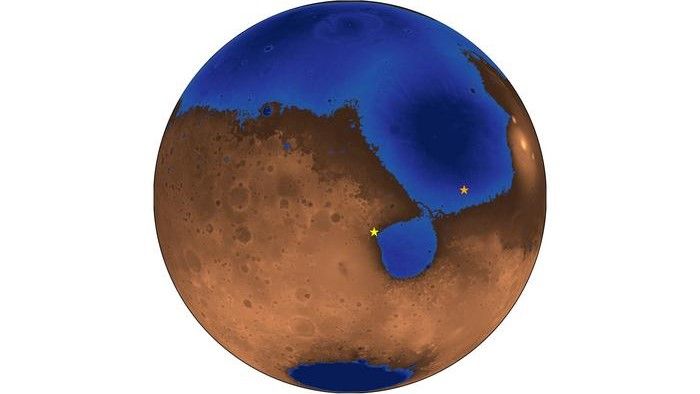Mars may once have been a prime holiday spot, with sandy beaches running along the shoreline of a large ocean, ground-penetrating radar by a Chinese rover has revealed.
The new findings, made by China’s Zhurong rover during its journey across the Red Planet, are the latest evidence that Mars had a gigantic ocean called Deuteronilus more than 3 billion years ago.
And much like the primordial seas of its neighbor Earth, this ancient ocean could have harbored life, the researchers say. The team published their findings Feb. 25 in the journal Proceedings of the National Academy of Sciences.
“We’re finding places on Mars that used to look like ancient beaches and ancient river deltas,” Benjamin Cardenas, assistant professor of geology at Penn State and co-author on the study, said in a statement. “We found evidence for wind, waves, no shortage of sand — a proper, vacation-style beach.”
The Zhurong rover landed on Mars in 2021 in Utopia Planitia, one of the oldest and largest impact basins on the Red Planet. Since then the rover has been trundling along a desiccated shoreline, scanning the surrounding geology for signs of evaporated water and ice.
Related: Enormous hidden ocean discovered under Mars could contain life
By scanning beneath the planet’s surface with radar, Zhurong discovered layered structures filled with formations known as foreshore deposits. Like on Earth’s beaches, these deposits are typically formed from sediments dropped by ocean tides and waves.
“This stood out to us immediately because it suggests there were waves, which means there was a dynamic interface of air and water,” Cardenas said. “When we look back at where the earliest life on Earth developed, it was in the interaction between oceans and land, so this is painting a picture of ancient habitable environments, capable of harboring conditions friendly toward microbial life.”
Further comparisons to Earth’s shores also helped the scientists to rule out other possible origins for these formations. Unlike those made by ancient river flows, wind or volcanic activity, the thickness and shape of these depressions are much more consistent with coastal origins.
“We’re seeing that the shoreline of this body of water evolved over time,” Cardenas said. “We tend to think about Mars as just a static snapshot of a planet, but it was evolving. Rivers were flowing, sediment was moving, and land was being built and eroded. This type of sedimentary geology can tell us what the landscape looked like, how they evolved, and, importantly, help us identify where we would want to look for past life.”
If it did exist, Deuteronilus likely disappeared just one billion years into Mars’s 4.5 billion year history — but this is plenty of time for primordial life forms to have thrived inside it. Yet that alone isn’t enough to suppose the planet did once harbor life.
Conclusive answers may not be too far off, however. Samples of Mars’ dust, and even evidence of ancient life, could have already been collected by the Perseverance rover, which has been exploring Jezero crater since 2021.
NASA initially planned for a retrieval mission to launch sometime in 2026, but this date has since been delayed until 2040 due to budget concerns. NASA is currently soliciting proposals from private companies to speed up the mission timeline.


